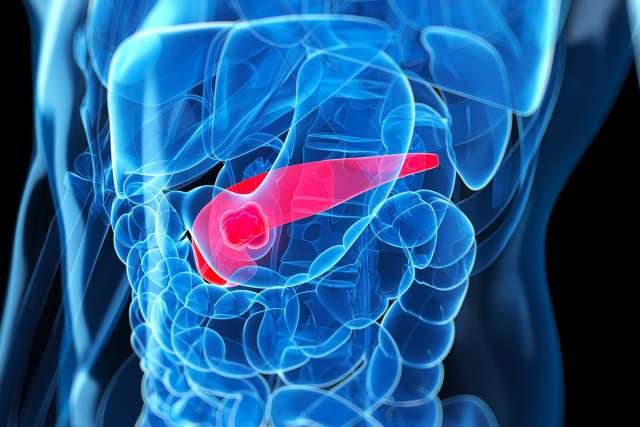Individuals who had taken a type of drug commonly used to treat Type 2 diabetes showed abnormalities in the pancreas, including cell proliferation, that may be associated with an increased risk of neuroendocrine tumors, according to a new study by researchers from UCLA and the University of Florida. Their findings were published online March 22 in the journal Diabetes.
The researchers, from the Larry L. Hillblom Islet Research Center at UCLA and the Diabetes Center at the University of Florida, found that cell mass was increased approximately 40 percent in the pancreases of deceased organ donors who had Type 2 diabetes and who had been treated with incretin therapy. This widely used type of treatment takes advantage of the action of a gut hormone known as glucagon-like peptide 1 (GLP-1) to lower blood sugar in the body.
Although there have been conflicting reports on the effects of the incretin class of drugs on the pancreas in animal studies, this is the first study to note such changes in the human pancreas. The research was made possible by a unique research consortium called nPOD (Network for Pancreatic Organ Donors with Diabetes), led by Dr. Mark Atkinson, a professor of pathology and pediatrics at the University of Florida. The network, which is funded by the Juvenile Diabetes Research Foundation, obtains pancreases from deceased organ donors, with permission of their next of kin, to better understand diabetes by investigating tissues of those with the disease.
"There is an increasing appreciation that animal studies do not always predict findings in humans," said Dr. Peter Butler, director of UCLA's Hillblom Islet Research Center and chief of the endocrinology, diabetes and hypertension unit. "The nPOD program is therefore a very precious resource."
The researchers examined the pancreases of 20 deceased organ donors with Type 2 diabetes. Eight had been treated for at least a year with incretin therapy, while the other 12 had received therapies that didn't include incretin-based drugs. The researchers also evaluated 14 pancreases from a control group of non-diabetic individuals of similar age.
The pancreases of the individuals who had been on incretin therapy were larger than those of patients on other types of diabetes therapies, and this larger size was associated with increased cellular proliferation. Incretin-treated individuals showed an increase in pancreas dysplasia, an abnormal form of cell proliferation that is a risk factor for pancreatic cancer, as well as an expansion of alpha cells, endocrine cells that make the hormone glucagon.
This latter finding is likely a consequence of GLP-1–based therapies' suppression of the release of glucagon by alpha cells, since decreasing the availability or action of the hormone glucagon has been shown in a variety of prior studies to induce a proliferation of pancreatic alpha cells. This alpha-cell expansion has been associated with the development of pancreatic neuroendocrine tumors. Three of the eight incretin-treated individuals had microadenomas and one has a neuroendocrine tumor composed of alpha cells.
Of the eight donors who were on incretin therapy, seven had been taking sitagliptin, sold in pill form as Januvia and marketed by Merck, and one had been on exenatide, sold as Byetta by Bristol-Myers Squibb. These and similar drugs are currently under investigation by the U.S. Food and Drug Administration for their possible links to pancreatitis and pancreatic cancer.
"These findings lend additional weight to concerns regarding the effects of long term GLP-1–related therapy, with respect to both unintended proliferative actions on the exocrine pancreas and now also a possible increased risk of neuroendocrine tumors," the researchers write. "In addition to the surveillance previously recommended for the potential association of GLP-1– based therapy and pancreatic cancer risk, the current data imply that surveillance for a possible increased risk of pancreatic neuroendocrine tumors is warranted."
Such surveillance approaches might include MRI imaging of the pancreas and screening for neuroendocrine tumors, Butler said.
"The present studies are only from a small number of individuals, and while the findings do raise concerns, it will be important that other approaches are now used in a larger group of living individuals to further investigate these findings," he said.
A recent study led by Dr. Sonal Singh of Johns Hopkins University School of Medicine and Public Health and published in JAMA Internal Medicine suggested a doubling in the risk of hospitalization for acute pancreatitis with the GLP-1–based therapies and also recommended further research.
"Since most risk factors for acute pancreatitis are also linked to an increased risk of pancreatic cancer, these findings of changes in the human pancreas are very concerning," said Singh, an assistant professor of medicine and international health. "Now that GLP-1–based therapies have been shown to increase the risk of pancreatic inflammation and abnormal cell proliferation, further studies are needed to urgently clarify whether these linkages lead to pancreatic cancer with long-term use."
Study co-authors, in addition to Butler and Atkinson, are Alexandra E. Butler, Tatyana Gurlo and David W. Dawson, all of UCLA, and Martha Campbell-Thompson of the University of Florida.
Grants from National Institute of Diabetes and Digestive and Kidney Diseases (DK059579, DK061539 and DK077967), the Hillblom Foundation, and the Peter and Valerie Kompaniez Foundation funded this study. The Juvenile Diabetes Research Foundation funds the nPOD program.




